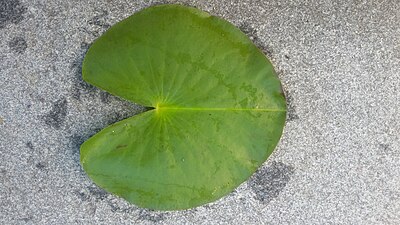| Nymphaea odorata subsp. tuberosa | |
|---|---|

| |
| Scientific classification | |
| Kingdom: | Plantae |
| Clade: | Tracheophytes |
| Clade: | Angiosperms |
| Order: | Nymphaeales |
| Family: | Nymphaeaceae |
| Genus: | Nymphaea |
| Subgenus: | Nymphaea subg. Nymphaea |
| Section: | Nymphaea sect. Nymphaea |
| Species: | N. odorata Aiton |
| Subspecies: | N. o. subsp. tuberosa |
| Trinomial name | |
| Nymphaea odorata subsp. tuberosa (Paine) Wiersma & Hellq. | |

| |
| Nymphaea odorata subsp. tuberosa is endemic to Canada and the USA | |
| Synonyms | |
List
| |
Nymphaea odorata subsp. tuberosa is a subspecies of Nymphaea odorata native to the region spanning from Central and Eastern Canada, extending to North Central and Northeastern United States.
Description
 Rhizomes of Nymphaea odorata subsp. tuberosa
Rhizomes of Nymphaea odorata subsp. tuberosa
 Adaxial leaf surface of Nymphaea odorata subsp. tuberosa
Adaxial leaf surface of Nymphaea odorata subsp. tuberosa
 Abaxial leaf surface of Nymphaea odorata subsp. tuberosa
Abaxial leaf surface of Nymphaea odorata subsp. tuberosa
Vegetative characteristics
Nymphaea odorata subsp. tuberosa has horizontal, tuberous, branched, 30-80 cm long, and 2-5 cm wide rhizomes. The leaves of mature plants float on the water, or extend 2-7 cm above the surface. The petiolate, orbicular leaves are 12-38 cm wide. The abaxial leaf surface is green or slightly purple. The petiole has brown to purple stripes. It has four primary central, and twelve secondary peripheral air canals.
Generative characteristics
The 10-23 cm wide flowers emerge 10-15 cm above the water surface. They have green, terete, 30-200 cm long, and 0.5-0.9 cm wide peduncles. The peduncles have red to brown stripes. The flowers have four sepals with a rounded apex. The white, obovate to spatulate petals have a rounded apex. The gynoecium consists of 14 carpels. The globose, 2.2 cm long, and 3.2 cm wide fruit bears 2.8-4.5 mm long seeds. The flowers are inodorous, or only very faintly fragrant.
Cytology
The haploid chromosome count is n = 42.
Reproduction
Vegetative reproduction
It can reproduce vegetatively by detached rhizomes.
Generative reproduction
Flowering occurs in late spring to summer. Fruiting occurs from July to October.
Taxonomy
Publication
It was described as Nymphaea tuberosa Paine by John Alsop Paine in 1865. Later, it was included in the species Nymphaea odorata Aiton as the subspecies Nymphaea odorata subsp. tuberosa (Paine) Wiersema & Hellq. published by John Harry Wiersema & Carl Barre Hellquist in 1994.
Type specimen
The lectotype was collected by J.A.Paine in Lake Ontario, near Rochester, USA in Aug 1865.
Position with in Nymphaea
It is placed in Nymphaea subg. Nymphaea.
Etymology
The subspecific epithet tuberosa, from the Latin tuberosus, means tuberous, or having a tuber.
Ecology
Habitat
It occurs in streams, rivers, ponds, and lakes.
Use
Food
The rhizomes are edible.
References
- ^ "Nymphaea odorata subsp. tuberosa (Paine) Wiersema & Hellq". Plants of the World Online. Royal Botanic Gardens, Kew. Retrieved 20 January 2024.
- ^ Conard, H. S. (2015). The Waterlilies: A Monograph of the Genus Nymphaea (Classic Reprint). pp. 189-192. USA: FB&C Limited.
- ^ Henkel, F., Rehnelt, F., Dittmann, L. (1907). "Das Buch der Nymphaeaceen oder Seerosengewächse." pp. 81-82. Deutschland: Henkel.
- ^ Wiersema, J. H., & Hellquist, C. B. (1994). NOMENCLATURAL NOTES IN NYMPHAEACEAE FOR THE NORTH AMERICAN FLORA. Rhodora, 96(886), 170–178. http://www.jstor.org/stable/23313084
- ^ Nymphaea odorata subsp. tuberosa - FNA. (n.d.). Retrieved January 21, 2024, from http://floranorthamerica.org/Nymphaea_odorata_subsp._tuberosa
- ^ Lahring, H. (2003). "Water and wetland plants of the Prairie Provinces." p. 189. USA: Canadian Plains Research Center, University of Regina.
- Chen, F., Liu, X., Yu, C., Chen, Y., Tang, H., & Zhang, L. (2017). "Water lilies as emerging models for Darwin’s abominable mystery." Horticulture research, 4.
- Nymphaea tuberosa | International Plant Names Index. (n.d.). Retrieved January 21, 2024, from https://www.ipni.org/n/311091-2
- Woods, K., Hilu, K. W., Wiersema, J. H., & Borsch, T. (2005). "Pattern of variation and systematics of Nymphaea odorata: I. Evidence from morphology and inter-simple sequence repeats (ISSRs)." Systematic Botany, 30(3), 471-480.
- Bayton, R. (2020). Practical Uses of Botanical Latin. In The Gardener's Botanical: An Encyclopedia of Latin Plant Names - with More than 5,000 Entries (pp. 22-318). Princeton: Princeton University Press. https://doi.org/10.1515/9780691209135-007
- Singapore Government. (n.d.-b). Ruellia tuberosa. Flora Fauna Web. Retrieved January 21, 2024, from https://www.nparks.gov.sg/florafaunaweb/flora/2/4/2404
- Vigna tuberosa | CasaBio. (n.d.). Retrieved January 21, 2024, from https://casabio.org/taxa/vigna-tuberosa
- Lim, T. K. (2016). "Edible Medicinal and Non-Medicinal Plants: Volume 11 Modified Stems, Roots, Bulbs." p. 8. Deutschland: Springer International Publishing.
| Taxon identifiers | |
|---|---|
| Nymphaea odorata subsp. tuberosa |
|
| Nymphaea tuberosa var. maxima | |